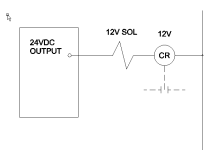ndzied1
Lifetime Supporting Member
I had a request to try to add something to a system that would check if the solenoid on a valve is burned out. I suppose one way would be to add a current sensor to the line with a discrete output and monitor that.
Another thought I had was what is in the attached image. Any thoughts on whether this would work or not? I know the coil is 22watts cold so that takes about 1.9Amps. If I put a small relay in there, will it get burned up by this much current?

Another thought I had was what is in the attached image. Any thoughts on whether this would work or not? I know the coil is 22watts cold so that takes about 1.9Amps. If I put a small relay in there, will it get burned up by this much current?







